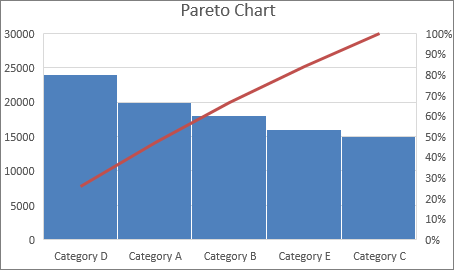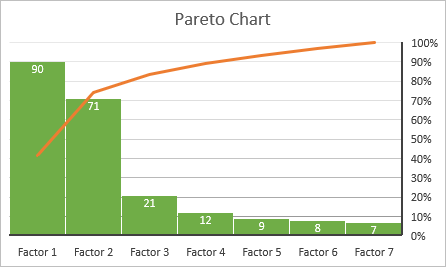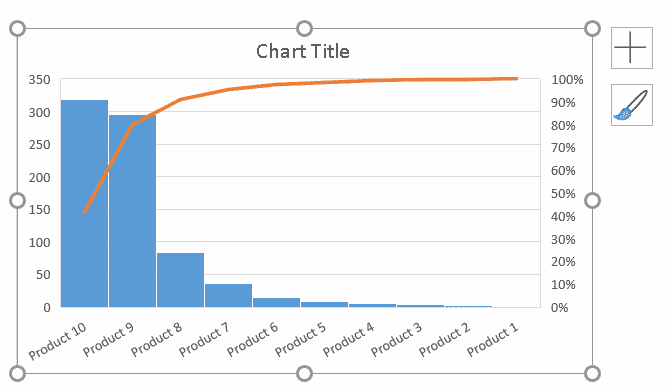
- Introduction to Pareto Chart Tool
- History of Pareto Chart Tool
- Pareto chart in excel – overview
- Why build a pareto chart in excel?
- Pareto Chart Tool
- How would you make a Pareto graph
- How to choose between a pareto chart (diagram) and a pareto analysis (table)?
- When to use a pareto chart?
- Pareto chart procedure
- Pareto Analysis Steps
- The Pareto Principle
- The Practical Importance
- Creating a Pareto Char
- Focusing of Pareto Chart Tool
- Why utilizes this device?
- How to use it
- Advantage and Disadvantage
- Conclusion
- Laying out boundaries is one of the primary administration elements of an association. On the off chance that the chiefs don’t focus on their assignments and hierarchical destinations, the association will head towards a misguided course and in the end, break down. Along these lines, the board is expected to focus on their undertakings and spotlight the need for things that will profoundly affect the association.
- The Pareto Chart instrument is one of the best devices that the administration can utilize about recognizing the realities required for defining boundaries. Pareto graphs show the data in a coordinated and relative way.
- Thusly, the administration can discover the overall significance of issues or reasons for the issues. With regards to focusing on the reasons for the issue, a Pareto graph can be utilized along with a circumstances and logical results chart.
- When the Pareto graph is made, it shows you an upward bar diagram with the most elevated significance to the least. The significance of every boundary is estimated by a few factors like recurrence, time, cost, and so forth
- To see the state of the information’s circulation,
- To dissect whether a cycle meets client prerequisites,
- To survey whether an interaction change has happened to start with one time span then onto the next,
- To decide if the results of at least two cycles are unique; and
- To impart the dissemination of information in a straightforward configuration.
- Perceive and investigate designs in the information that are not evident; and
- Plan points and settle on choices by portraying how well or inadequately a cycle is performing.
- A Pareto Chart or Pareto Diagram assists with transforming your information into clear visualizable noteworthy bits of knowledge. It features the main thing by placing accentuation on the main drivers of a peculiarity.
- A Pareto Chart is a superb device to outline and legitimize a short-rundown of the main errands in an undertaking the board set. It tends to be joined with other venture prioritization strategies like Einsehower’s Urgent-Important Matrix.
- So, a Pareto Chart is a main driver identifier graph that might outline the presence of a Pareto circulation inside your information. A Pareto Distribution is seen when the Pareto Principle holds. The Pareto Principle (or “20-80 rule” or “Law of the Vital Few”) expresses that, for some occasions, generally 80% of the impacts come from 20% of the causes.
- Helps center regard for the most basic issues.
- Focuses on the possible reason for the issue.
- Distinguishes the basic not many from the careless many.
- We can take a guide to see how Pareto regulation is applied and the way that Pareto’s outline is made to recognize the basic underlying drivers of issues we are confronting.
- Allow us to inspect the number of objections that are gotten at an inn that offers both housing and boarding. The administration has gathered the different grumblings and the times a specific sort of objection has happened. The following is the example information for the equivalent.
- Decide the classifications that wish to screen or effects the business
- Layout an estimation framework, and critical to involve similar measures for all donors.
- Decide the timetable that information covers for the Pareto for every one of the classes.
- Gather information for every one of the classes in two sections, classifications (model: sort of imperfections) in the primary segment and relating recurrence (absolute count of each deformity classification) in the subsequent segment.
- Draw a reference diagram with classifications (model: kind of imperfections) in the x-pivot and recurrence on the y-hub.
- Re-request the classes in plunging request (from biggest to littlest classifications).
- Then, at that point, ascertain the combined level of every class in the sliding request. i.e Individual deformity count/complete imperfections count *100.
- Draw one more upward pivot on the right half of the chart with values from 0 to 100 percent.
- Plot the total level of every class on the x-hub.
- Presently join every one of the places, it will shape a bend.
- Break down the diagram. Distinguish the top 80% on the Y-hub. This point on the x-pivot partitions the indispensable few imperfections (left side) and insignificant many deformities on the right side.
- If the informational index basic your Pareto Analysis is made of restricted “causes or drivers” to investigate, a Pareto Chart (graph) is unquestionably the best approach. On the off chance that the informational index has a huge assortment of “cause or drivers”, crunching the information with an immediate Pareto Analysis (table) in a sheet is more proper because a Pareto Chart will be dispensed with such a large number of snippets of data and won’t yield clear visualizable and noteworthy experiences.
- A Pareto Analysis should be possible physically as clarified in this Pareto Analysis Excel instructional exercise. To mechanize a Pareto Analysis in only a single tick like displayed in the DEMO part of this site, you can involve an Excel Pareto Analysis Add-In. An Excel Add-in is especially valuable for Excel clients who need to do Pareto Analysis in Excel consistently.
- The Excel Pareto Analysis Add-In likewise assists with saving time when the informational index to examine is characterized with dynamic channels in Excel. These channels can remain set up while involving the Add-in consequently staying away from extra tedious strides of information readiness, for example, fabricating a transitory informational index from the important subset of information and so on.
- While examining information about the recurrence of issues or causes in a cycle
- At the point when there are numerous issues or causes and you need to zero in on the most huge
- While investigating expansive causes by taking a gander at their particular parts
- While speaking with others about your information
- Decide what classifications you will use to bunch things.
- Decide what estimation is fitting. Normal estimations are recurrence, amount, cost, and time.
- Decide what timeframe the Pareto diagram will cover: One work cycle? One entire day? Seven days?
- Collect the information, record the classification each time, or gather the information that as of now exists.
- Subtotal the estimations for every classification.
- Construct and name bars for every class. Place the tallest at the extreme left, then, at that point, the following tallest on its right side, etc. On the off chance that there are numerous classifications with little estimations, they can be gathered as “other.”
- Calculate the rate for every classification: the subtotal for that class isolated by the all-out for all classifications. Draw a right upward pivot and name it with rates. Be certain the two scales match. For instance, the left estimation that compares to one-half ought to be inverse half on the right scale.
- Calculate and draw aggregate totals: add the subtotals for the first and second classes, and spot a dab over the subsequent bar showing that total. To that aggregate add the subtotal for the third classification, and spot a dab over the third bar for that new total. Proceed with the interaction for every one of the bars. Draw an obvious conclusion, beginning at the highest point of the principal bar. The last speck should reach 100 percent on the right scale.
- Whenever a group cooperates in an enormous and complex undertaking, it very well may be very precarious to comprehend the significance of specific issues. Pareto outlines can show the group a couple of significant things that truly make the biggest difference.
- Most groups use Pareto outlines over the long run to recognize whether the proposed arrangement truly answers the issue. Assuming the arrangement is viable, the overall significance of the distinguished component should take a lesser worth over the long run.
- A Pareto Chart is a diagram that shows the recurrence of deformities, as well as their total effect. Pareto Charts are valuable to track down the deformities to focus on to notice the best by and large improvement
- The thought behind a Pareto Chart is that a couple of most huge imperfections make up the greater part of the general issue. We take care of currently two different ways the Pareto Charts assist with observing the imperfections that have the most aggregate impact.
- To begin with, the primary bars are dependably the tallest, demonstrating the most widely recognized wellsprings of deformities. Second, the combined rate line shows which deformities to focus on to get the most general improvement.
- Kind of wellbeing occurrences that happen
- Reasons for a particular kind of issue
- Purposes behind the retraction
- You might have information previously gathered, for example from episode announcing, or you may need to assemble information explicitly. You should orchestrate your information in a table appearance number in every classification of interest.
- Pareto outlines work best on the off chance that you have over 30 perceptions across the classes diagramed (even though assuming you have a ton of classifications you might require more information). More modest numbers can be deluding because of irregular possibilities.
- The order by classes is just a manual for where to concentrate consideration. It doesn’t let you know that something individual to that classification is the reason for the various frequencies seen. In the model above, you might choose to begin improvement endeavors inward 24L – although you would have to consider different things, for example, the availability of the staff there to be involved.
- It is valuable to know whether basic cycles are steady (just irregular variety) across the period for the information in the Pareto graph, to accurately decipher it. Pareto graphs don’t clarify what kind of variety is being noticed.
- It assists with recognizing the top main drivers.
- Assists with focusing on the top issue for an issue and attempting to kill it first.
- Gives a thought of the aggregate effect of issues.
- Remedial and Preventive activity can be better arranged.
- Gives a focused, basic, and clear method for tracking down imperative few causes.
- Assists with further developing critical thinking and dynamic abilities.
- Works on the adequacy of value the board.
- Helpful in each type of initiative choice.
- Helps in using time effectively, be working, or individual.
- Helps in the everyday execution of the board.
- Helps in arranging, investigation, and investigating too.
- Helps in critical thinking and direction.
- Helps in change the executives.
- Helps in using time effectively.
- Pareto Analysis can’t observe underlying drivers without anyone else. It should be utilized alongside other Root Causes Analysis apparatuses to determine the main drivers.
- It doesn’t show the seriousness of the issue.
- It centers around past information where harm has as of now occurred. Some of the time it probably won’t be pertinent for future situations.
- It can’t be applied to all cases.
Introduction to Pareto Chart Tool:
History of Pareto Chart Tool:
A histogram is the most ordinarily involved chart to show how regularly each unique worth in a bunch of information happens (known as recurrence dispersion). A group can utilize a histogram:
Histograms can help a group:
Pareto chart in excel – overview
1. Gather the Raw Data including the Category (reason for an issue) and their Count
Total Percentage
It is the technique for computing the recurrence circulation and will be determined progressively by adding the percent with different frequencies. In this way, the recipe will be =D6+C7. Subsequent to arranging the qualities from biggest to littlest, we compute the aggregate rate for every one of the classifications.
2. Select class, count, and combined percent Range together as displayed beneath
3. Select the combined percent bars and change the series outline type to Line.
4. Right-click on the combined absolute line (in red) and pick design information series.
5. Click on the right-hand hub and select arrangement hub.
Why build a pareto chart in excel?
Pareto Chart Tool:
The Pareto Chart tool is perhaps the most integral asset utilized in critical thinking. At the point when we are burdened with numerous things, we should focus on. Pareto outline is utilized widely in quality administration to focus on the different underlying drivers and issues. This aids in zeroing in on taking out the basic few. Pareto graph and method depend on Pareto Law, which says that 80% of the issues are brought about by 20% of the underlying drivers. We ought not to be channelizing our endeavors on minor things. A Pareto diagram is an arranged histogram giving a visual portrayal of the discoveries.

How would you make a Pareto graph?
Click Insert > Insert Statistic Chart, and afterward under Histogram, pick Pareto. You can likewise involve the All-Charts tab in Recommended Charts to make a Pareto graph (click Insert > Recommended Charts > All Charts tab.
The most effective method to develop a Pareto Chart:
The Pareto outline’s main role is to distinguish the most successive deformities, blunders that can be counted and sorted. The following are the means to make a Pareto diagram utilizing the Pareto Analysis.
How to choose between a pareto chart (diagram) and a pareto analysis (table)?
When to use a pareto chart?
Pareto chart procedure
Determine the proper scale for the estimations you have gathered. The greatest worth will be the biggest subtotal from stage 5. (Assuming that you will do discretionary stages 8 and 9 underneath, the greatest worth will be the amount of all subtotals from stage 5.) Mark the scale on the left half of the graph.
Note: Steps 8 and 9 are discretionary however are helpful for investigation and correspondence.
Pareto Analysis Steps:
Presently, we’ll investigate how to complete a Pareto Analysis:
1. Distinguish and List Problems: Work out a rundown of each of the issues that you want to determine. Where conceivable, assemble criticism from clients and colleagues. This could appear as client studies, formal objections, or helpdesk logs, for instance.
2. Distinguish the Root Cause of Each Problem: Then, get to the main driver of every issue. Procedures like the 5 Whys , Cause, and Effect Analysis, and Root Cause Analysis are valuable instruments for this.
3. Score Problems: Presently, score every issue that you’ve recorded by significance. The scoring strategy that you use will rely upon the kind of issue that you’re attempting to determine. For instance, to further develop benefits, you could score issues by the amount they cost. Or on the other hand, assuming you’re attempting to further develop consumer loyalty, you may score them given the number of grievances that you’ve gotten with regards to each.
4. Gather Problems Together: Utilize the underlying driver investigation that you completed in Step 3 to assemble issues for a normal reason. For instance, if three of your concerns are brought about by the absence of staff, you could put these into a similar gathering.
5. Include Scores for Each Group: Presently, include the scores for each gathering that you’ve recognized. The one with the top score ought to be your most noteworthy need, and the gathering with the least score your least need.
6. Make a move: At last, it’s an ideal opportunity to make a move! Your most elevated scoring issue will probably have the greatest result once fixed, so begin conceptualizing thoughts on the best way to settle this one first. You might observe that your most reduced scoring issues do not merit making a fuss over, especially assuming they are expensive to fix. Utilize your Pareto Analysis to save your energy and assets for what’s significant!
The Pareto Principle:
Pareto outlines are made in light of the Pareto rule. The standard recommends that when various elements influence what is happening, fewer factors will be responsible for the vast majority of the effect. This is practically equivalent to the 80/20 hypothesis that you might have known about. It says that 80% of the effect is made by 20% of causes.

The Practical Importance:
Creating a Pareto Chart:
Stage 1 First of all, rundown down all that you want to think about. This can be a rundown of issues, things, or a rundown of issue causes.
Stage 2 Decide on the standard measures to analyze the rundown things. You want to consider authoritative destinations and the latest things to decide the actions. A few measures are Frequency – How frequently it happens Errors, objections, entanglements, and so forth Cost – what number of assets are being used or impacted
Time – What amount of time it requires
Stage 3 Select a period for the information assortment process.
Stage 4 Now, we do some straightforward math with the information we gathered. Take each rundown thing or cause and record it against the estimation chosen. Then, at that point, decide its rate in the unique circumstance and all thing events
Stage 5 Create a bar graph. The rundown things ought to be shown along with the ‘Y’ hub from most noteworthy to the least. Left upward hub should be the action that you chose. In our model, it should be the number of events. Select the right upward pivot as the aggregate rate. Everything ought to have a bar.
Stage 6 Now, define a boundary chart for total rates. The primary mark of the line ought to be on the highest point of the main bar. You can utilize accounting page programming like Microsoft Excel for this progression.
Stae 7 Analyze your diagram. You presently need to recognize the things that seem to have the most effect. Distinguish the breakpoint of a rapid change in the diagram refertheredcircle.
Assuming there is no breakpoint, account for the causes/things that have half or more effectiveness. In our model, there is an apparent breakpoint. There are two causes before the breakpoint, Road traffic and Work till Late Night. Hence, the two causes that have the most effect on our concern are Road Traffic and Work till Late Night.
Focusing of Pareto Chart Tool:
Why utilizes this device?
Utilizing a Pareto outline assists a group with focusing its improvement endeavors on the variables that have the best effect. It likewise assists a group with conveying the reasoning for zeroing in on specific regions. For instance, you should take a gander at.
They are a valuable apparatus while recognizing open doors for development, yet additionally in penetrating down to comprehend the explanations behind unique causes on diagrams showing counts, rates, and rates.
How to use it.

Advantage and Disadvantage:
The advantages are as per the following:
Disadvantage:
Conclusion:
Pareto graph is a basic yet exceptionally compelling diagram that permits focusing on different components and a visual portrayal of the discoveries. Pareto outlines are effectively made utilizing Excel.






